Nursing Assignment 6: Ethical and Legal Challenges Case Study Scenario
VerifiedAdded on 2020/04/21
|7
|1480
|81
Case Study
AI Summary
This nursing assignment presents a case study of a terminally ill patient with lung cancer who refuses further treatment, exploring the ethical and legal challenges that arise. The assignment examines the conflict between patient autonomy and beneficence, highlighting the nurse's role in respecting the patient's decisions while also considering potential adverse health outcomes. Key legal complexities, such as informed consent, are discussed, along with the importance of ethical decision-making processes guided by nursing codes of ethics. The assignment emphasizes the need for effective communication, collaboration with the patient's family, and the use of tools like 'at own risk' forms to ensure patient rights are upheld. It concludes by underscoring the significance of nurses' understanding of their responsibilities in such situations, particularly when a patient refuses treatment, and the importance of providing comprehensive information to facilitate informed decisions.
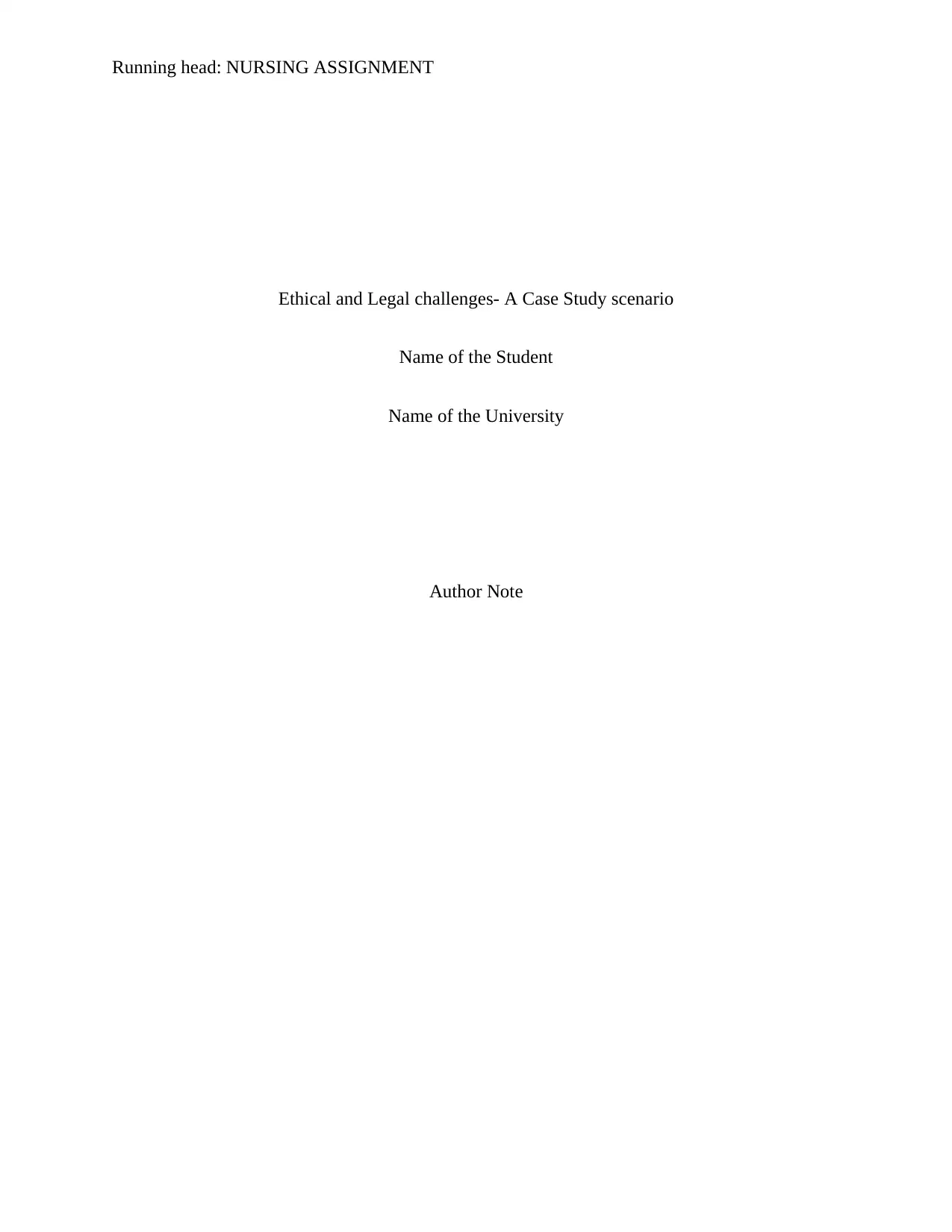
Running head: NURSING ASSIGNMENT
Ethical and Legal challenges- A Case Study scenario
Name of the Student
Name of the University
Author Note
Ethical and Legal challenges- A Case Study scenario
Name of the Student
Name of the University
Author Note
Paraphrase This Document
Need a fresh take? Get an instant paraphrase of this document with our AI Paraphraser
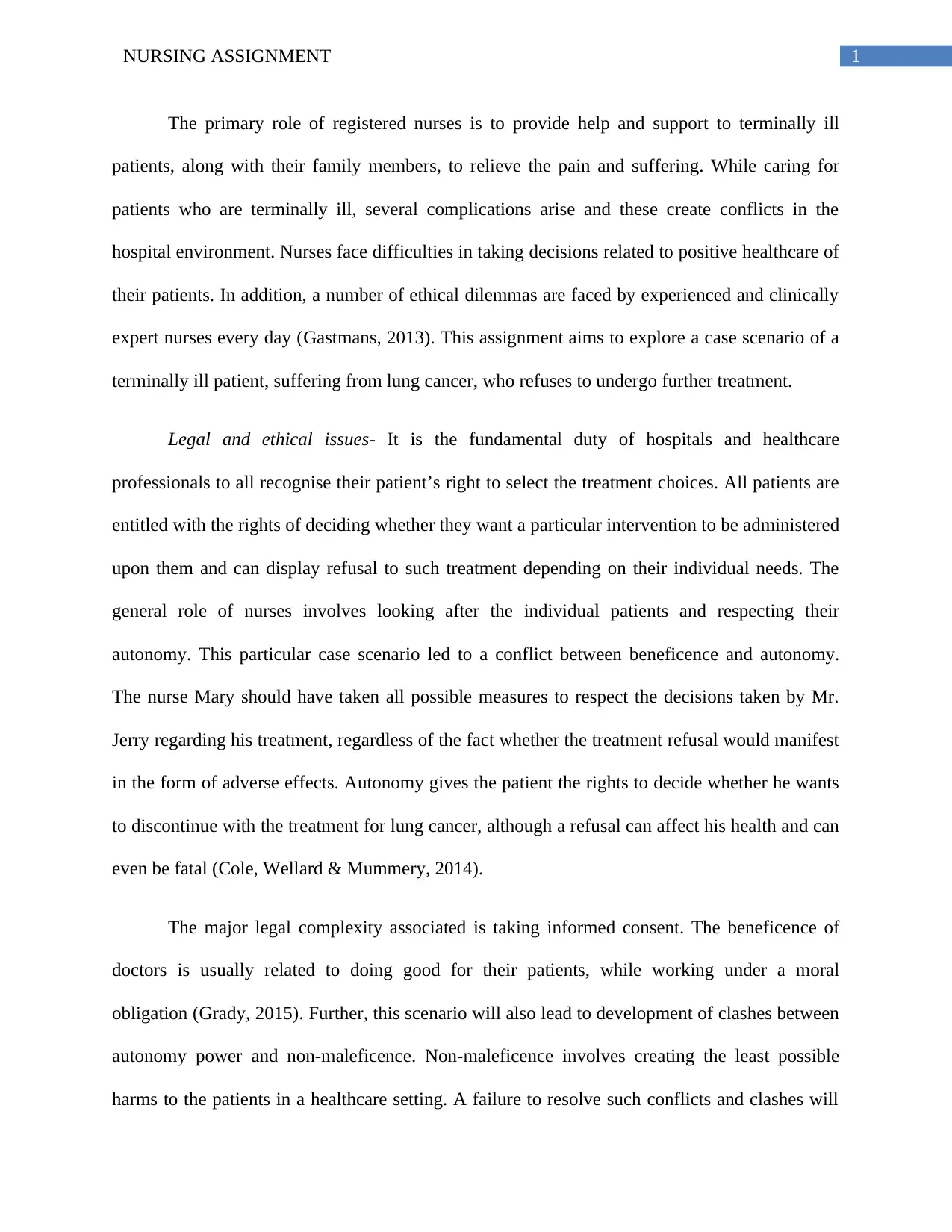
1NURSING ASSIGNMENT
The primary role of registered nurses is to provide help and support to terminally ill
patients, along with their family members, to relieve the pain and suffering. While caring for
patients who are terminally ill, several complications arise and these create conflicts in the
hospital environment. Nurses face difficulties in taking decisions related to positive healthcare of
their patients. In addition, a number of ethical dilemmas are faced by experienced and clinically
expert nurses every day (Gastmans, 2013). This assignment aims to explore a case scenario of a
terminally ill patient, suffering from lung cancer, who refuses to undergo further treatment.
Legal and ethical issues- It is the fundamental duty of hospitals and healthcare
professionals to all recognise their patient’s right to select the treatment choices. All patients are
entitled with the rights of deciding whether they want a particular intervention to be administered
upon them and can display refusal to such treatment depending on their individual needs. The
general role of nurses involves looking after the individual patients and respecting their
autonomy. This particular case scenario led to a conflict between beneficence and autonomy.
The nurse Mary should have taken all possible measures to respect the decisions taken by Mr.
Jerry regarding his treatment, regardless of the fact whether the treatment refusal would manifest
in the form of adverse effects. Autonomy gives the patient the rights to decide whether he wants
to discontinue with the treatment for lung cancer, although a refusal can affect his health and can
even be fatal (Cole, Wellard & Mummery, 2014).
The major legal complexity associated is taking informed consent. The beneficence of
doctors is usually related to doing good for their patients, while working under a moral
obligation (Grady, 2015). Further, this scenario will also lead to development of clashes between
autonomy power and non-maleficence. Non-maleficence involves creating the least possible
harms to the patients in a healthcare setting. A failure to resolve such conflicts and clashes will
The primary role of registered nurses is to provide help and support to terminally ill
patients, along with their family members, to relieve the pain and suffering. While caring for
patients who are terminally ill, several complications arise and these create conflicts in the
hospital environment. Nurses face difficulties in taking decisions related to positive healthcare of
their patients. In addition, a number of ethical dilemmas are faced by experienced and clinically
expert nurses every day (Gastmans, 2013). This assignment aims to explore a case scenario of a
terminally ill patient, suffering from lung cancer, who refuses to undergo further treatment.
Legal and ethical issues- It is the fundamental duty of hospitals and healthcare
professionals to all recognise their patient’s right to select the treatment choices. All patients are
entitled with the rights of deciding whether they want a particular intervention to be administered
upon them and can display refusal to such treatment depending on their individual needs. The
general role of nurses involves looking after the individual patients and respecting their
autonomy. This particular case scenario led to a conflict between beneficence and autonomy.
The nurse Mary should have taken all possible measures to respect the decisions taken by Mr.
Jerry regarding his treatment, regardless of the fact whether the treatment refusal would manifest
in the form of adverse effects. Autonomy gives the patient the rights to decide whether he wants
to discontinue with the treatment for lung cancer, although a refusal can affect his health and can
even be fatal (Cole, Wellard & Mummery, 2014).
The major legal complexity associated is taking informed consent. The beneficence of
doctors is usually related to doing good for their patients, while working under a moral
obligation (Grady, 2015). Further, this scenario will also lead to development of clashes between
autonomy power and non-maleficence. Non-maleficence involves creating the least possible
harms to the patients in a healthcare setting. A failure to resolve such conflicts and clashes will
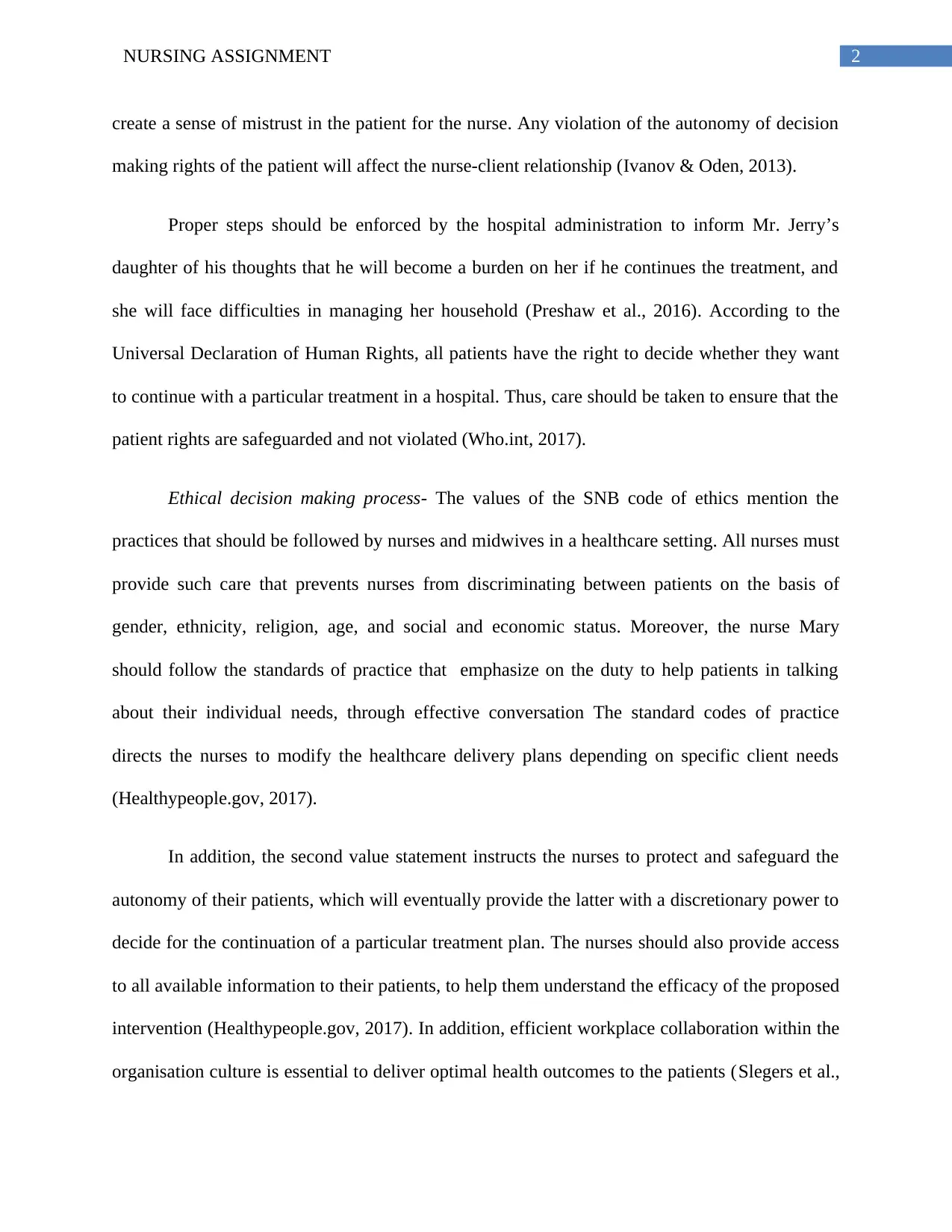
2NURSING ASSIGNMENT
create a sense of mistrust in the patient for the nurse. Any violation of the autonomy of decision
making rights of the patient will affect the nurse-client relationship (Ivanov & Oden, 2013).
Proper steps should be enforced by the hospital administration to inform Mr. Jerry’s
daughter of his thoughts that he will become a burden on her if he continues the treatment, and
she will face difficulties in managing her household (Preshaw et al., 2016). According to the
Universal Declaration of Human Rights, all patients have the right to decide whether they want
to continue with a particular treatment in a hospital. Thus, care should be taken to ensure that the
patient rights are safeguarded and not violated (Who.int, 2017).
Ethical decision making process- The values of the SNB code of ethics mention the
practices that should be followed by nurses and midwives in a healthcare setting. All nurses must
provide such care that prevents nurses from discriminating between patients on the basis of
gender, ethnicity, religion, age, and social and economic status. Moreover, the nurse Mary
should follow the standards of practice that emphasize on the duty to help patients in talking
about their individual needs, through effective conversation The standard codes of practice
directs the nurses to modify the healthcare delivery plans depending on specific client needs
(Healthypeople.gov, 2017).
In addition, the second value statement instructs the nurses to protect and safeguard the
autonomy of their patients, which will eventually provide the latter with a discretionary power to
decide for the continuation of a particular treatment plan. The nurses should also provide access
to all available information to their patients, to help them understand the efficacy of the proposed
intervention (Healthypeople.gov, 2017). In addition, efficient workplace collaboration within the
organisation culture is essential to deliver optimal health outcomes to the patients (Slegers et al.,
create a sense of mistrust in the patient for the nurse. Any violation of the autonomy of decision
making rights of the patient will affect the nurse-client relationship (Ivanov & Oden, 2013).
Proper steps should be enforced by the hospital administration to inform Mr. Jerry’s
daughter of his thoughts that he will become a burden on her if he continues the treatment, and
she will face difficulties in managing her household (Preshaw et al., 2016). According to the
Universal Declaration of Human Rights, all patients have the right to decide whether they want
to continue with a particular treatment in a hospital. Thus, care should be taken to ensure that the
patient rights are safeguarded and not violated (Who.int, 2017).
Ethical decision making process- The values of the SNB code of ethics mention the
practices that should be followed by nurses and midwives in a healthcare setting. All nurses must
provide such care that prevents nurses from discriminating between patients on the basis of
gender, ethnicity, religion, age, and social and economic status. Moreover, the nurse Mary
should follow the standards of practice that emphasize on the duty to help patients in talking
about their individual needs, through effective conversation The standard codes of practice
directs the nurses to modify the healthcare delivery plans depending on specific client needs
(Healthypeople.gov, 2017).
In addition, the second value statement instructs the nurses to protect and safeguard the
autonomy of their patients, which will eventually provide the latter with a discretionary power to
decide for the continuation of a particular treatment plan. The nurses should also provide access
to all available information to their patients, to help them understand the efficacy of the proposed
intervention (Healthypeople.gov, 2017). In addition, efficient workplace collaboration within the
organisation culture is essential to deliver optimal health outcomes to the patients (Slegers et al.,
⊘ This is a preview!⊘
Do you want full access?
Subscribe today to unlock all pages.

Trusted by 1+ million students worldwide
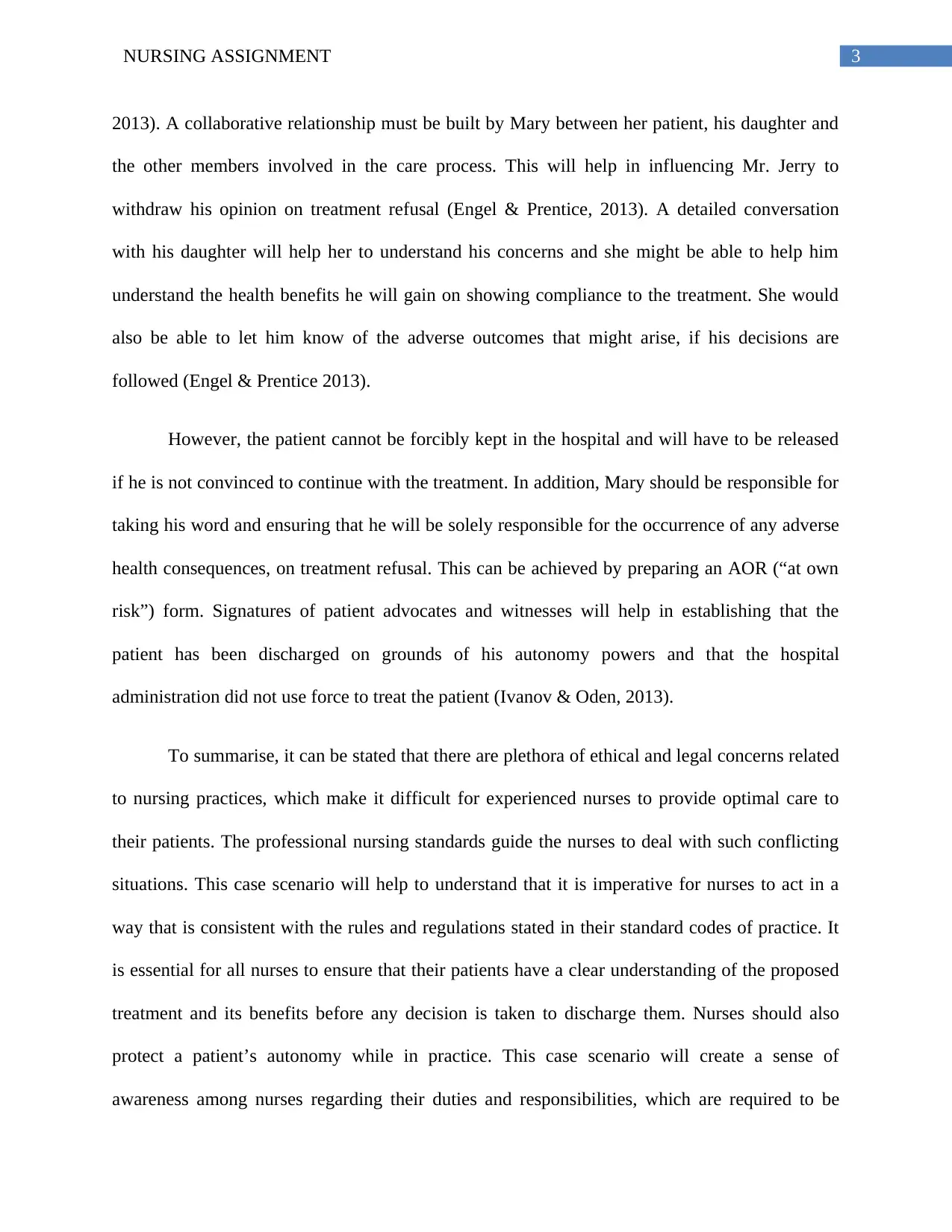
3NURSING ASSIGNMENT
2013). A collaborative relationship must be built by Mary between her patient, his daughter and
the other members involved in the care process. This will help in influencing Mr. Jerry to
withdraw his opinion on treatment refusal (Engel & Prentice, 2013). A detailed conversation
with his daughter will help her to understand his concerns and she might be able to help him
understand the health benefits he will gain on showing compliance to the treatment. She would
also be able to let him know of the adverse outcomes that might arise, if his decisions are
followed (Engel & Prentice 2013).
However, the patient cannot be forcibly kept in the hospital and will have to be released
if he is not convinced to continue with the treatment. In addition, Mary should be responsible for
taking his word and ensuring that he will be solely responsible for the occurrence of any adverse
health consequences, on treatment refusal. This can be achieved by preparing an AOR (“at own
risk”) form. Signatures of patient advocates and witnesses will help in establishing that the
patient has been discharged on grounds of his autonomy powers and that the hospital
administration did not use force to treat the patient (Ivanov & Oden, 2013).
To summarise, it can be stated that there are plethora of ethical and legal concerns related
to nursing practices, which make it difficult for experienced nurses to provide optimal care to
their patients. The professional nursing standards guide the nurses to deal with such conflicting
situations. This case scenario will help to understand that it is imperative for nurses to act in a
way that is consistent with the rules and regulations stated in their standard codes of practice. It
is essential for all nurses to ensure that their patients have a clear understanding of the proposed
treatment and its benefits before any decision is taken to discharge them. Nurses should also
protect a patient’s autonomy while in practice. This case scenario will create a sense of
awareness among nurses regarding their duties and responsibilities, which are required to be
2013). A collaborative relationship must be built by Mary between her patient, his daughter and
the other members involved in the care process. This will help in influencing Mr. Jerry to
withdraw his opinion on treatment refusal (Engel & Prentice, 2013). A detailed conversation
with his daughter will help her to understand his concerns and she might be able to help him
understand the health benefits he will gain on showing compliance to the treatment. She would
also be able to let him know of the adverse outcomes that might arise, if his decisions are
followed (Engel & Prentice 2013).
However, the patient cannot be forcibly kept in the hospital and will have to be released
if he is not convinced to continue with the treatment. In addition, Mary should be responsible for
taking his word and ensuring that he will be solely responsible for the occurrence of any adverse
health consequences, on treatment refusal. This can be achieved by preparing an AOR (“at own
risk”) form. Signatures of patient advocates and witnesses will help in establishing that the
patient has been discharged on grounds of his autonomy powers and that the hospital
administration did not use force to treat the patient (Ivanov & Oden, 2013).
To summarise, it can be stated that there are plethora of ethical and legal concerns related
to nursing practices, which make it difficult for experienced nurses to provide optimal care to
their patients. The professional nursing standards guide the nurses to deal with such conflicting
situations. This case scenario will help to understand that it is imperative for nurses to act in a
way that is consistent with the rules and regulations stated in their standard codes of practice. It
is essential for all nurses to ensure that their patients have a clear understanding of the proposed
treatment and its benefits before any decision is taken to discharge them. Nurses should also
protect a patient’s autonomy while in practice. This case scenario will create a sense of
awareness among nurses regarding their duties and responsibilities, which are required to be
Paraphrase This Document
Need a fresh take? Get an instant paraphrase of this document with our AI Paraphraser
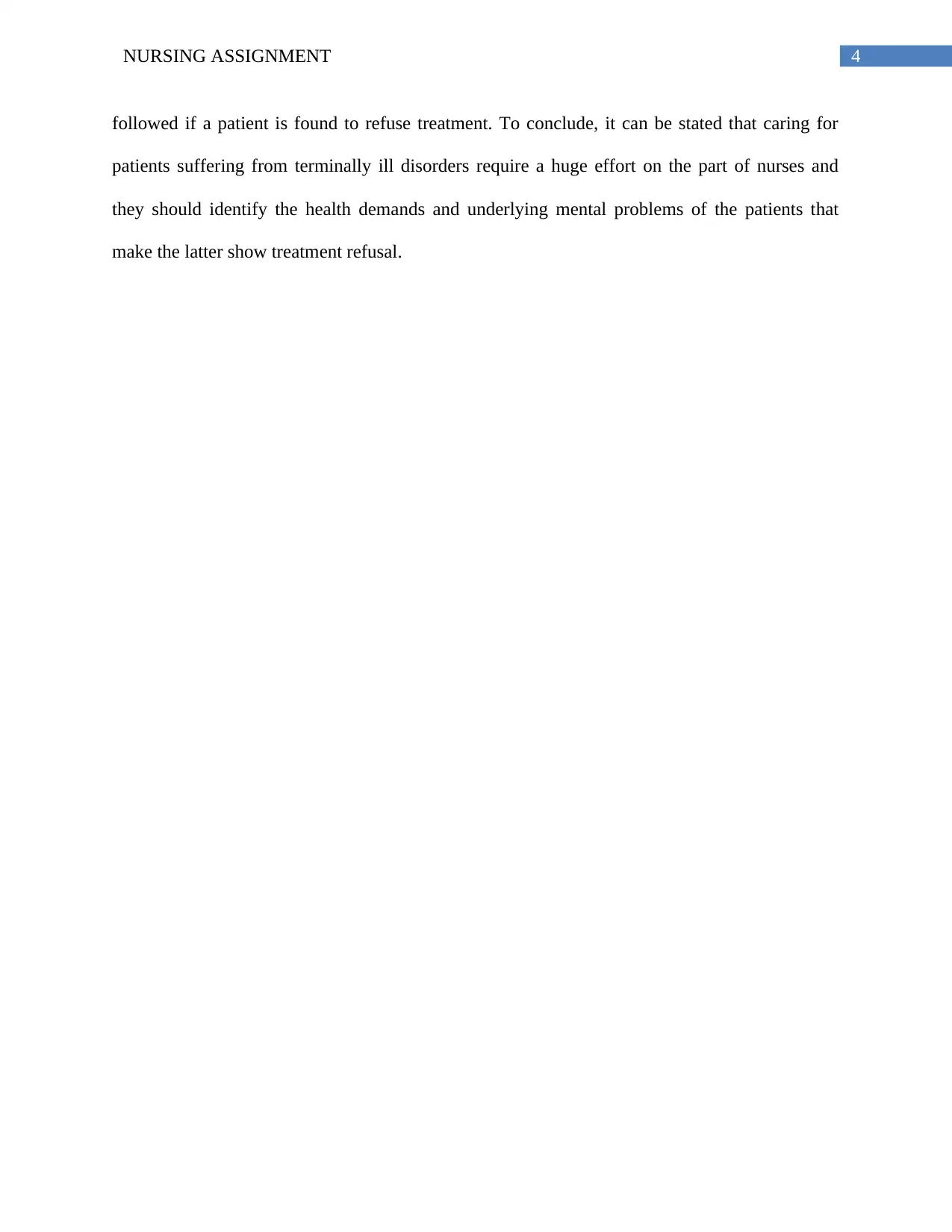
4NURSING ASSIGNMENT
followed if a patient is found to refuse treatment. To conclude, it can be stated that caring for
patients suffering from terminally ill disorders require a huge effort on the part of nurses and
they should identify the health demands and underlying mental problems of the patients that
make the latter show treatment refusal.
followed if a patient is found to refuse treatment. To conclude, it can be stated that caring for
patients suffering from terminally ill disorders require a huge effort on the part of nurses and
they should identify the health demands and underlying mental problems of the patients that
make the latter show treatment refusal.
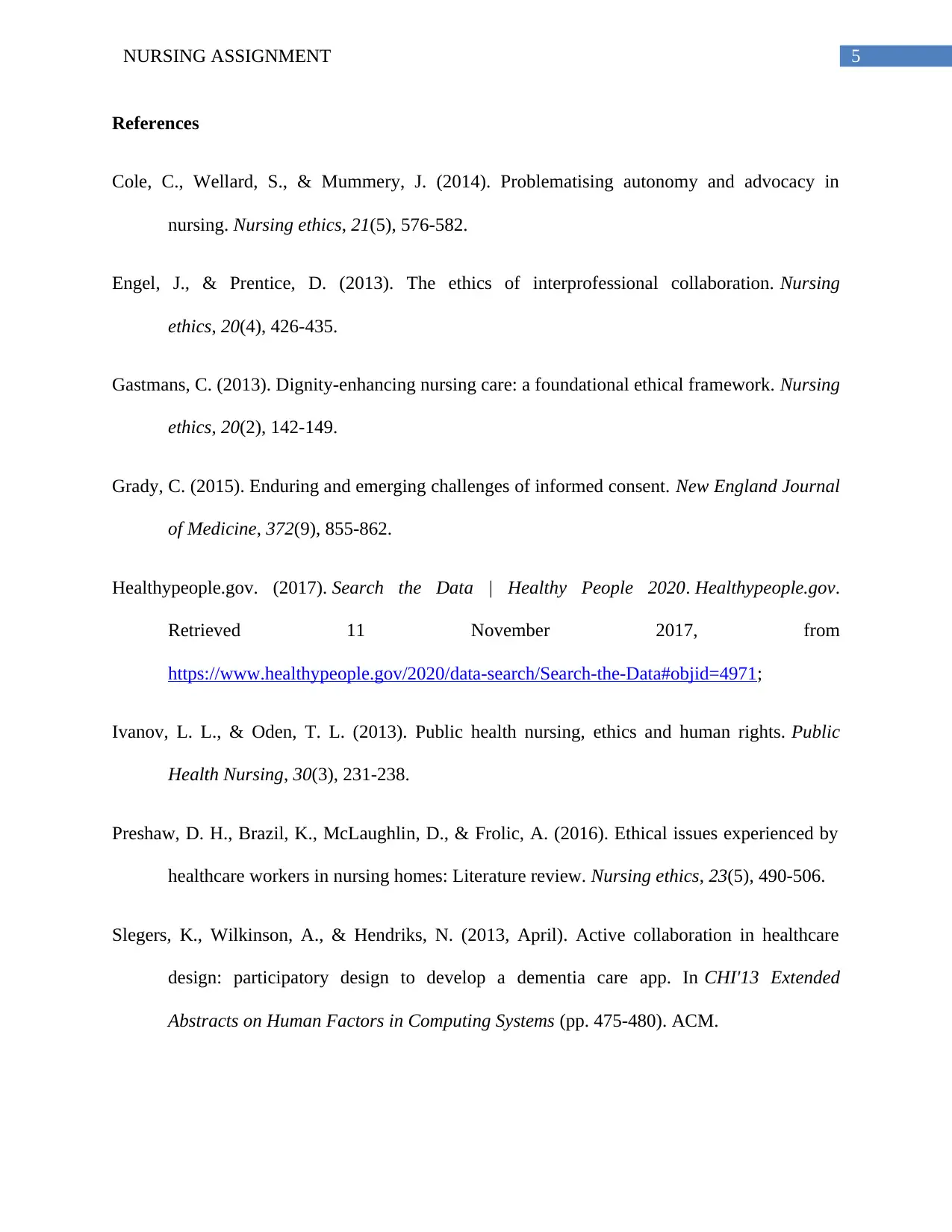
5NURSING ASSIGNMENT
References
Cole, C., Wellard, S., & Mummery, J. (2014). Problematising autonomy and advocacy in
nursing. Nursing ethics, 21(5), 576-582.
Engel, J., & Prentice, D. (2013). The ethics of interprofessional collaboration. Nursing
ethics, 20(4), 426-435.
Gastmans, C. (2013). Dignity-enhancing nursing care: a foundational ethical framework. Nursing
ethics, 20(2), 142-149.
Grady, C. (2015). Enduring and emerging challenges of informed consent. New England Journal
of Medicine, 372(9), 855-862.
Healthypeople.gov. (2017). Search the Data | Healthy People 2020. Healthypeople.gov.
Retrieved 11 November 2017, from
https://www.healthypeople.gov/2020/data-search/Search-the-Data#objid=4971;
Ivanov, L. L., & Oden, T. L. (2013). Public health nursing, ethics and human rights. Public
Health Nursing, 30(3), 231-238.
Preshaw, D. H., Brazil, K., McLaughlin, D., & Frolic, A. (2016). Ethical issues experienced by
healthcare workers in nursing homes: Literature review. Nursing ethics, 23(5), 490-506.
Slegers, K., Wilkinson, A., & Hendriks, N. (2013, April). Active collaboration in healthcare
design: participatory design to develop a dementia care app. In CHI'13 Extended
Abstracts on Human Factors in Computing Systems (pp. 475-480). ACM.
References
Cole, C., Wellard, S., & Mummery, J. (2014). Problematising autonomy and advocacy in
nursing. Nursing ethics, 21(5), 576-582.
Engel, J., & Prentice, D. (2013). The ethics of interprofessional collaboration. Nursing
ethics, 20(4), 426-435.
Gastmans, C. (2013). Dignity-enhancing nursing care: a foundational ethical framework. Nursing
ethics, 20(2), 142-149.
Grady, C. (2015). Enduring and emerging challenges of informed consent. New England Journal
of Medicine, 372(9), 855-862.
Healthypeople.gov. (2017). Search the Data | Healthy People 2020. Healthypeople.gov.
Retrieved 11 November 2017, from
https://www.healthypeople.gov/2020/data-search/Search-the-Data#objid=4971;
Ivanov, L. L., & Oden, T. L. (2013). Public health nursing, ethics and human rights. Public
Health Nursing, 30(3), 231-238.
Preshaw, D. H., Brazil, K., McLaughlin, D., & Frolic, A. (2016). Ethical issues experienced by
healthcare workers in nursing homes: Literature review. Nursing ethics, 23(5), 490-506.
Slegers, K., Wilkinson, A., & Hendriks, N. (2013, April). Active collaboration in healthcare
design: participatory design to develop a dementia care app. In CHI'13 Extended
Abstracts on Human Factors in Computing Systems (pp. 475-480). ACM.
⊘ This is a preview!⊘
Do you want full access?
Subscribe today to unlock all pages.

Trusted by 1+ million students worldwide
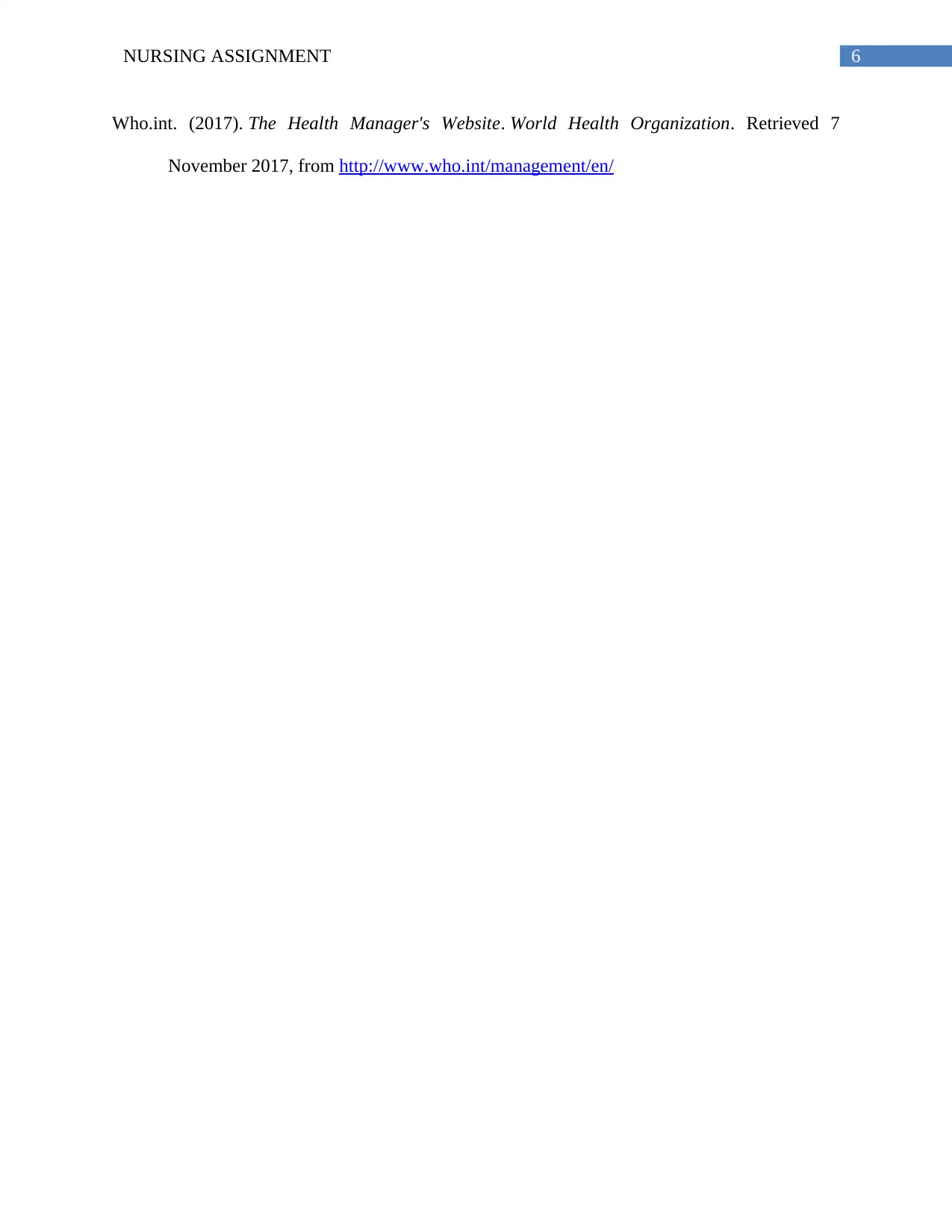
6NURSING ASSIGNMENT
Who.int. (2017). The Health Manager's Website. World Health Organization. Retrieved 7
November 2017, from http://www.who.int/management/en/
Who.int. (2017). The Health Manager's Website. World Health Organization. Retrieved 7
November 2017, from http://www.who.int/management/en/
1 out of 7
Related Documents
Your All-in-One AI-Powered Toolkit for Academic Success.
+13062052269
info@desklib.com
Available 24*7 on WhatsApp / Email
![[object Object]](/_next/static/media/star-bottom.7253800d.svg)
Unlock your academic potential
Copyright © 2020–2025 A2Z Services. All Rights Reserved. Developed and managed by ZUCOL.





